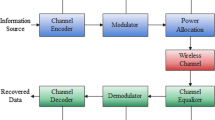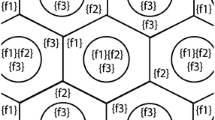Abstract
The aim of this paper is to introduce a novel frequency reuse concept especially for macro cellular networks to substantially increase the mobile network capacity, and simultaneously to avoid the implementation of low efficient small cells. Single path multiple access (SPMA) utilizes the characteristics of independent propagation paths for particular geographical location in the coverage area of mobile network. The proposed concept is based on the assumption that new approach will be adopted by the antenna manufacturers for producing advanced antennas by utilizing materials like metamaterials including carbon based nanotechnology, and graphene. In SPMA concept, communication between base station and mobile station happens through only single independent propagation path, and frequency resources can be reused in 5 m \(\times \) 5 m areas or even more often in 1 m \(\times \) 1 m areas, but limited by a base station/mobile station antenna requirement. Thus, the capacity of the network will be increased dramatically, and it can be managed in centralized manner at certain macro site locations. In already deployed cellular networks, these macro sites are mostly easily available, and that would help to implement SPMA to enhance the network capacity. Simulation results provided in this paper show the applicability of SPMA technique, by limiting the radiation of signal as single path propagation between base station and mobile station.












Similar content being viewed by others
References
Wang, L. C., Chawla, K., & Greenstein, L. J. (1998). Performance studies of narrow-beam trisector cellular systems. International Journal of Wireless Information Networks, 5(2), 89–102.
Stevanović, I.V., Skrivervik, A., & Mosig, J. R. (2003). Smart antenna systems for mobile communications. Laboratoire d’Electromagnetisme et d’Acoustique Ecole Polytechnique Federale de Lausanne, January 2003.
Niemela, J., & Lempiainen, J. (2003). Impact of the base station antenna beamwidth on capacity in WCDMA cellular networks. In Proceedings of the IEEE 57th semiannual vehicular technology conference, 2003 (Vol. 1, pp. 80–84).
Wacker, A., Laiho-Steffens, J., Sipilä, K., & Heiska, K. (1999). The impact of the base station sectorisation on WCDMA radio network performance. In Proceedings of 50th IEEE vehicular technology conference, 1999 (pp. 2611–2615).
Cabrera, D., & Rodriguez, J. (2004). Switched beam smart antenna BER performance analysis for 3G CDMA cellular communication. In Computer research conference CRC2004, Puerto Rico.
Bhobe, A. U., & Perini, P. L. (2001). An overview of smart antenna technology for wireless communication. IEEE Aerospace Conference, 2, 875–883.
Balanis, C. A. (2005). Antenna theory: Analysis and design (3rd ed.). New York: Wiley.
Hoydis, J., Brink, S. T., & Debbah, M. (2013). Massive MIMO in the UL/DL of cellular networks: How many antennas do we need? IEEE Journal on Selected Areas in Communications, 31(2), 160–171.
Huh, H., Caire, G., Papadopoulos, H. C., & Ramprashad, S. A. (2012). Achieving ”massive MIMO” spectral efficiency with a not-so-large number of antennas. IEEE Transactions on Wireless Communications, 11(9), 3226–3239.
Son, H. W., & Myung, N. H. (1999). A deterministic ray tube method for microcellular wave propagation prediction model. IEEE Transactions on Antennas and Propagation, 47(8), 1344–1350.
Schettino, D. N., Moreira, F. J. S., & Rego, C. G. (2007). Efficient ray tracing for radio channel characterization of Urban scenarios. IEEE Transactions on Magnetics, 43(4), 1305–1308.
Soni, S., & Bhattacharya, A. (2012). An efficient two-dimensional ray-tracing algorithm for modeling or urban microcellular environment. International Journal of Electronics and Communications (AEU), 66(6), 439–447.
Zhu, F., Lin, Q., Hu, J. (2005). A directive patch antenna with a metamaterial cover. In Asia-Pacific conference proceedings, microwave conference proceedings, APMC 2005. (Vol. 3, pp. 3) 4–7 Dec. 2005.
Jun, H., Chun-seng, Y., & Qing-chun, L. (2005). A new patch antenna with meta material cover. Journal of Zhejiang University Science A. doi:10.1631/jzus.2006.A0089.
Gomez-Diaz, J. S., Perruisseau-Carrier, J. (2012). Microwave to THz properties of graphene and potential antenna applications. In International symposium on antennas and propagation (ISAP), 2012 (pp. 239–242), Oct. 29 2012–Nov. 2 2012.
Perruisseau-Carrier, J. (2012). Graphene for antenna applications: Opportunities and challenges from microwaves to THz. Antennas and propagation conference (LAPC), 2012 Loughborough (pp. 1–4), 12–13 Nov. 2012.
Llatser, I., Kremers, C., Chigrin, D.N., Jornet, J.M., Lemme, M.C. & Cabellos-Aparicio, A. (2012). Characterization of graphene-based nano-antennas in the terahertz band. In 6th European conference on antennas and propagation (EUCAP), 2012 (pp. 194–198, 26–30).
Larsson, E. G., Tufvesson, F., Edfors, O., & Marzetta, T. L. (2014). Massive MIMO for next generation wireless systems. IEEE Communications Magazine, 52(2), 186–195.
Schurig, D., et al. (2006). Metamaterial electromagnetic cloak at microwave frequencies. Science, 314(5801), 977–980.
Jornet, J. M., & Akyildiz, I. F. (2010). Graphene-based nano-antennas for electromagnetic nanocommunications in the terahertz band. In Proceedings of 4th European conference on antennas and propagation, EUCAP, 2010.
Weldon, J., Jensen, K., & Zettl, A. (2008). Nanomechanical radio transmitter. Physica Status Solidi B, 245(10), 2323–2325.
Acknowledgments
Authors would like to thank European Communications Engineering (ECE) Ltd for funding this research work.
Author information
Authors and Affiliations
Corresponding author
Rights and permissions
About this article
Cite this article
Sheikh, M.U., Lempiäinen, J. Will New Antenna Materials Enable Single Path Multiple Access (SPMA)?. Wireless Pers Commun 78, 979–994 (2014). https://doi.org/10.1007/s11277-014-1796-x
Published:
Issue Date:
DOI: https://doi.org/10.1007/s11277-014-1796-x




